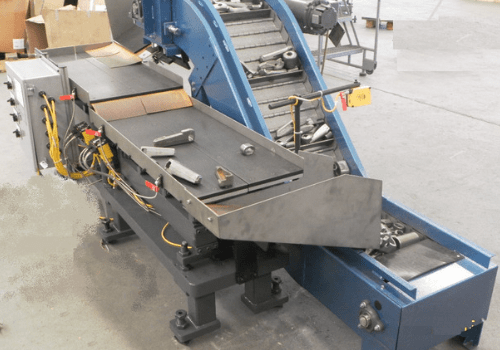Vibratory bowl feeders are specialized automation devices used in manufacturing processes to orient and feed components or parts in a controlled manner. They consist of a bowl-shaped container mounted on a base, which vibrates to move and orient the parts along the track or bowl circumference. They are widely used in industries to efficiently handle various parts with precision and reliability.
At Vibromatic Co., we have been at the forefront of providing innovative vibratory feeder solutions tailored to meet our customers’ specific needs. Our range of premium products has become synonymous with reliability, efficiency, and precision, automating assembly lines worldwide.

How Do Vibratory Bowl Feeders Operate?
A vibratory bowl feeder is a complex system that uses precise engineering to ensure efficient operation. Here is a detailed look into its operational mechanisms:
- Bowl VibrationThe bowl, typically made of stainless steel or other durable materials, is mounted on a base equipped with springs. When the electromagnetic coil within the base drive unit along with the springs are activated, it creates a vibratory drive motion. These vibrations cause the parts within the bowl to move along a predetermined path, ensuring a smooth and consistent flow of components.
- Parts OrientationAs parts move along the bowl’s track, they encounter various obstacles and tooling, such as ramps and grooves, that orient them into a specific position. This ensures that parts are correctly aligned before reaching the next stage in the manufacturing process. The orientation tooling is customized based on the parts being handled, along with part configuration and feed rate ensuring that each part is oriented accurately.
- Parts Selection ToolingVibratory bowl feeders are equipped with parts selection tooling to further enhance efficiency. This may include tooling mechanisms like sweeps, cord sections, profile windows along with mechanical gates, or sensors. These tools sort and separate parts, ensuring that only correctly oriented components proceed to the next stage. Incorrectly oriented or defective parts are redirected back into the bowl for another pass, minimizing errors and improving overall system reliability.
The Role of Vibratory Bowl Feeders in Industrial Process Automation
The integration of vibratory bowl feeders into manufacturing processes brings several key benefits:
Efficiency
Vibratory bowl feeders eliminate the need for manual handling. This important automation tool leads to a smoother production line, reducing bottlenecks and increasing overall throughput. In addition, the feeders’ ability to operate continuously and consistently ensures a steady supply of correctly oriented parts to downstream processes, optimizing workflow and productivity.
Precision
A vibratory bowl feeder is designed to handle parts accurately, ensuring each component is correctly oriented before it reaches the next production stage. This precise orientation is achieved through custom-designed tooling that moves the oriented parts along the feeder’s track. The result is high consistency and quality in the assembled products, minimizing defects and rework.
Versatility
Vibratory feeders can handle various parts, shapes, and sizes, making them suitable for multiple industries. Whether the parts are small and delicate or large and robust, these systems can be tailored to their specific requirements, including the capability of feeding and orienting several part variants within the same feeder system
Integration with Automated Systems
Most vibratory bowl feeders can be integrated with other automated systems, such as robotic arms, conveyor belts, and inspection stations. This enhances the overall automation of the manufacturing process, enabling seamless transitions between different stages. For instance, robotic arms can pick correctly oriented parts from the feeder and place them onto a conveyor belt, transporting them to the next workstation. This reduces human intervention, increases process reliability, and enhances production speed.
Cost-Effectiveness
While the initial investment in a vibratory bowl feeder can be significant, its long-term cost savings are substantial. By automating part feeding and orientation, manufacturers can reduce labor costs, minimize material waste, and increase production output. The system’s durability and low maintenance requirements further contribute to its cost-effectiveness, offering a high return on investment over its operational lifespan.
Customization
Vibratory bowl feeders can be customized to meet the specific needs of different manufacturing processes. Customization options include the design of the bowl and track, the type of vibration mechanism, and the orientation and selection tooling. This allows Vibromatic to tailor the feeder system to each manufacturer’s unique requirements., ensuring optimal performance and efficiency on their assembly line.
Common Parts Vibratory Bowl Feeders Can Handle
Vibratory bowl feeders are incredibly versatile and can handle a wide array of parts, including:
● Small components: electronic parts, screws, and other miniature components
● Fasteners: nuts, bolts, and screws used in various industries
● Metal parts: components used in automotive, aerospace, and industrial machinery
● Plastic parts: molded parts used in consumer goods and electronics
● Food products: candy, nuts, and small packaged foods
● Pharmaceutical/Medical components: pills, capsules, and other small medical items
● Automotive parts: engine components, fasteners, and other car parts
● Cosmetic products: containers, caps, and other packaging items
● Parts to be packaged: various items that need to be oriented and fed into packaging machines
Comprehensive Vibratory Feeder Systems and Components at Vibromatic Co.
At Vibromatic Co., we manufacture and supply premium vibratory feeder systems and components to meet manufacturer’s diverse requirements. Here are some of our offerings:

